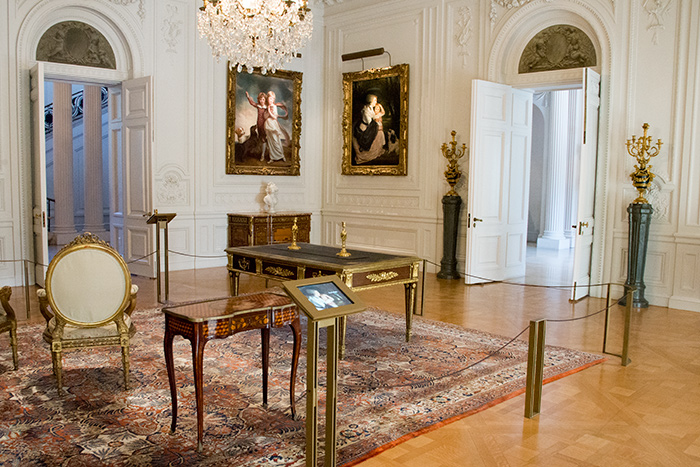Posted on Tue., March 17, 2015 by

In the past, sumptuous furnishings may have tempted visitors to touch. Now, thanks to interactive displays—such as this one on the Savonnerie carpets—visitors can.
One of the first things visitors encounter in the mansion that houses the Huntington Art Gallery is a series of first-floor period rooms that Henry and Arabella Huntington inhabited in the early decades of the 20th century. But for many years, visitors could only skirt the edges of the rooms, making it difficult to imagine the Huntingtons’ lifestyle or really get a sense of their exquisite European art collection.
Now a new layout, better signage, and iPads are helping to bring the Huntingtons and their collection to life. Doors that were once closed between the rooms—the Large Library, Large Drawing Room, Small Drawing Room, and Dining Room—are now open. Visitors can move around and among the rooms, making it easier to take in the sumptuousness of the ornate decorations and gain closer, unobstructed views of the precious artworks, furniture, and decorative objects on display. A panel in each room orients the visitor, and smaller displays and iPads offer additional detail.

Open doors and better access in the Large Drawing Room and other period rooms allow visitors to explore the spaces Henry and Arabella Huntington inhabited. iPads offer detailed histories about the precious objects the rooms contain.
In the Large Library, you can sit in chairs inspired by Arabella’s favorite chairs and gaze at the treasures around you. These include a set of Beauvais tapestries after designs by François Boucher, purchased by Henry Huntington in 1909, and two opulent wool Savonnerie carpets designed for Louis XIV’s redecoration of the Louvre palace in the late 17th century. There are also scores of volumes from Henry’s vast book collection—just a sampling of the hundreds of thousands of books and manuscripts he collected during his lifetime, a number so large that he would build the Library to house them all in 1920. At one of the nearby iPads, you can touch the screen and see an animated video (viewable below) that reveals how the drawers of an 18th-century mechanical writing table open and close.
In the Large Drawing Room, the Huntingtons' taste for elegant sophistication is evident in the finely hand-carved wall panels and intricate French furnishings. Visitors are invited to touch a reproduction of a gilded metal mount attached to an 18th-century chest of drawers by German cabinet-maker Martin Carlin and imagine how it would catch the candlelight.
Next door, in the Small Drawing Room, you can tap another iPad to view details of an exquisite French mantel clock, created by renowned 18th-century clockmaker-to-the-kings Renacle-Nicolas Sotiau in the early 1780s. The ermine-clad fellow in Sévres porcelain at the top of the clock is its original owner, Prince Maximilian of Hapsburg, brother of Marie-Antoinette of France.
Finally, stop by the Dining Room. Next to the large table and glimmering chandelier is a photograph showing the room decked out for a 1926 luncheon in honor of the Crown Prince of Sweden. The photo helps you envisage dinnertime chez Huntington. Henry and Arabella would appear each evening for dinner at 7 p.m. in formal attire. Four butlers waited on them, two who served and two who stood ready. Quite the life indeed.

Take a seat, really. The chairs on the right are modeled after Arabella’s favorite chairs and are meant for sitting.
If you haven’t visited the Huntington Art Gallery in a while, come check out the period rooms. These spaces, even while gloriously “stuck in time,” continue to evolve.
The video of a mechanical writing table is part of a suite of five short, silent videos that are installed on iPads in the period rooms. The videos, focusing on objects and architectural features in the period rooms, are also viewable online on Vimeo and YouTube.
Diana W. Thompson is senior writer for the office of communications and marketing at The Huntington.